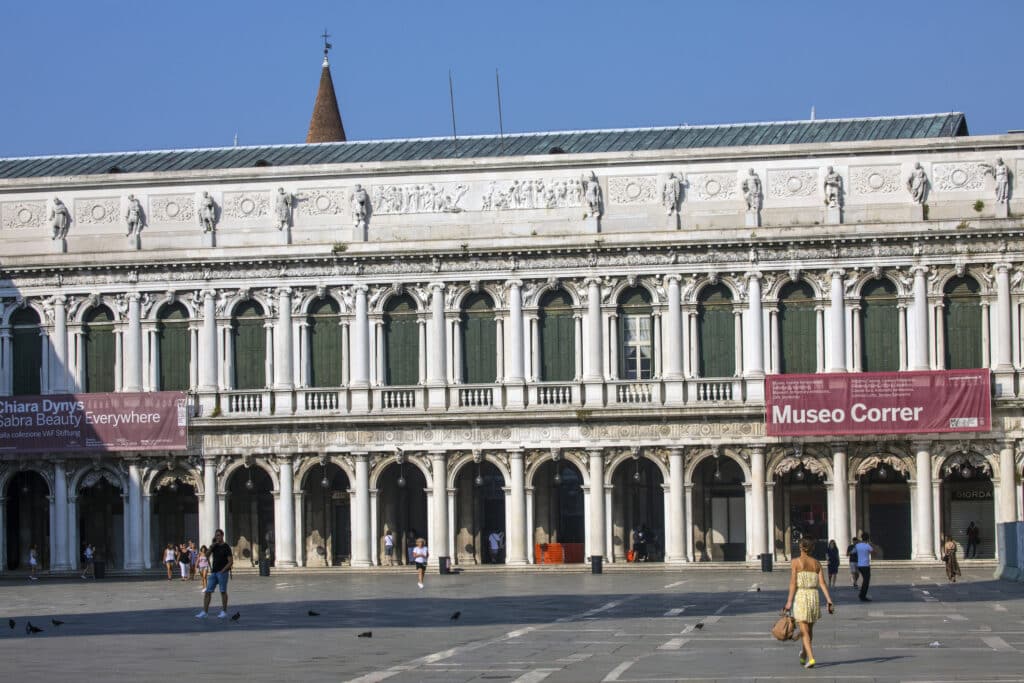
The standard entrance ticket to the Correr Museum (part of the St. Mark’s Square Museums combination) costs €30 for adults in 2025 (reduced to €25 if booked online at least a month early). Reduced tickets are €15 and apply to youths (ages 6–14), students (15–25), and seniors (65+). Children under 6 years old enjoy free entry. Family groups (two adults with at least one child under 14) get tickets at the reduced price for everyone, and there are special school group rates in the off-season.
Notably, this single “St. Mark’s Square Museums” ticket also covers entry to the Doge’s Palace as well as the Museo Correr, the National Archaeological Museum, and the Monumental Rooms of the Biblioteca Marciana – a great value if you plan to visit multiple attractions. Alternatively, visitors who want to see all of Venice’s civic museums can opt for the Museum Pass (valid for 6 months), which is €40 for adults or €22 reduced and grants one-time access to a dozen museums across the city.
The museum is open daily (no fixed closing day). Opening hours vary by season: from 10:00 to 18:00 (last admission 17:00) during the high season months of April through October, and 10:00 to 17:00 (last entry 16:00) from November through March. During summer 2025, there are even extended evening hours – every Friday and Saturday the Correr Museum stays open until 23:00 (with final entry at 22:00) , offering a chance to experience the exhibits in a quieter, after-hours ambiance. (These late openings apply only to the Museo Correr’s sections on those nights.) We visited the museum on 3 June 2025, and all the information here is confirmed to be accurate as of that date.
Inside the Museum: History and Highlights
One of the lavishly decorated neoclassical rooms in the Museo Correr’s Royal Palace section. Inside the Museo Correr, visitors step into what was once Venice’s Royal Palace – a splendid suite of neoclassical halls built during the Napoleonic era.
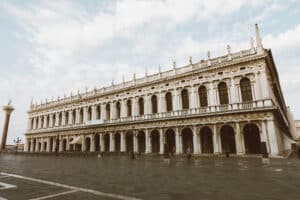
Panoramic view of façade of Museo Correr and Piazza San Marco
What can you expect to find inside the Correr Museum? For one, a journey through Venice’s rich art and history spread across magnificent Imperial chambers. The museum occupies the Napoleonic Wing of Piazza San Marco, an area Napoleon Bonaparte himself redeveloped in the early 19th century as his residence when he conquered Venice.. (In fact, Napoleon demolished an old church on this site to build his new palace, signaling the start of a new era.) Later used by the Austrian Habsburgs as a royal residence, these rooms retain an opulent charm – we’re talking about grand salons with chandeliers, gilded décor and classical frescoes on the ceilings.
Walking through the Ballroom, Throne Room and Banquet Hall of the palace, we felt transported to a bygone age of imperial splendor. In these chambers you will also find sculptures by the renowned Antonio Canova, such as his marble Daedalus and Icarus, exemplifying the Neoclassical art that adorns the palace. We lingered in the ballroom, admiring the elegant stuccoes and the gleaming Venetian chandeliers – it’s definately one of the most stunning interiors in Venice.
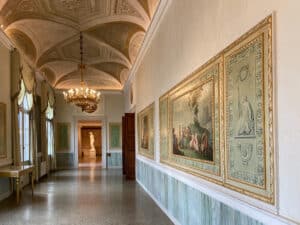
Decorated hallway in Correr Museum in Venice city
The Museo Correr’s origins date back to 1830, when a passionate Venetian collector, Teodoro Correr, bequeathed his entire collection to the city . Thanks to Correr’s foresight (and subsequent donations by other citizens), the museum today boasts a remarkably comprehensive set of exhibits that illuminate Venice’s heritage. After the ornate imperial rooms, the museum’s route leads into galleries devoted to the history and daily life of the Venetian Republic.
Ever wondered how the Venetian Republic was governed, or what its navy looked like? Here you’ll find the answers. We browsed displays of historic documents, navigational instruments, and detailed maps that chart the expansion of Venice’s maritime empire. One section features an almost complete collection of coins minted by Venice from the early Middle Ages until 1797 – its great to see such a numismatic timeline presented in one place, and indeed we found it fascinating how the coins evolved over a millennium. Nearby, there are beautifully drawn nautical maps and globes from the 15th–16th centuries, which really put into perspective Venice’s view of the world during its Age of Exploration. We were also intrigued by the display of weapons and model ships, including a detailed model of the famed Venetian galleys, and even an example of an 18th-century Ottoman ceremonial tent captured during Venice’s wars – tangible reminders of the Republic’s military and naval prowess.
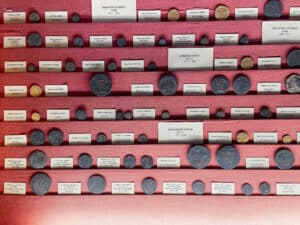
Collection of ancient coins in Correr Museum
The museum experience continues upstairs in the art galleries, which focus on Venetian painting up to the 16th century. The Picture Gallery is arranged largely around the original art collection of Teodoro Correr and includes masterpieces by major Venetian artists. We saw early Renaissance works by Giovanni Bellini – including his moving Dead Christ Supported by Two Angels – and captivating scenes by Vittore Carpaccio (such as Two Venetian Ladies in all their elegant finery).. There are also exquisite pieces by Antonello da Messina, Cosmè Tura, and others . For us, seeing these paintings in the context of Venice’s own civic museum felt special; it’s like the city telling its own story through art.
The gallery isn’t overwhelming in scale, but it’s very well curated. We’d recommend taking a moment to appreciate the famed bird’s-eye view map of Venice by Jacopo de’ Barbari (on display in the later rooms) – it’s an astonishingly detailed 16th-century map that spreads across a whole wall, depicting Venice in painstaking detail. In short, the Museo Correr covers a bit of everything: opulent Imperial-era rooms, insightful historical collections, and fine art. It manages to be both an art museum and a history museum, which is why we found the visit so rewarding. It truly offers a crash course in Venetian civilization – as Condé Nast Traveler aptly noted, it’s “one of the best places to get a crash course in Venetian history” (and we wholeheartedly agree). Not to mention, the museum’s location is part of a UNESCO World Heritage Site – the entirety of Venice and its lagoon has been inscribed by UNESCO since 1987 – underscoring the global importance of the cultural treasures you’re exploring here.
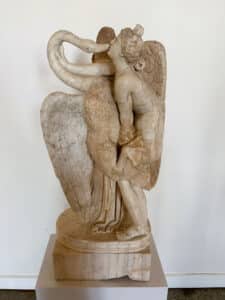
Leda and the Swan in Correr Museum
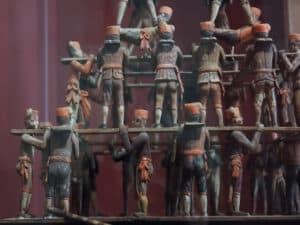
Museum Correr in Venice

Before moving on, here are a couple of tips from our experience. Plan on spending at least 1.5 to 2 hours inside Museo Correr to fully appreciate its collections (we easily spent about two hours during our visit). Photography is allowed in most areas (no flash), so you can capture those beautiful rooms and artworks for memories. There are information panels in English throughout, but an audio guide is available if you want a more in-depth narration (for a small extra fee). The museum is laid out in a one-way flow that eventually leads you to connected institutions – specifically the adjacent Archaeological Museum and the Marciana Library’s historic reading rooms – which are included in your ticket. Don’t rush through these: we stepped into the Archaeological Museum section and suddenly found ourselves amid ancient Roman statuary and Greek antiquities, a nice contrast after the Renaissance art. And finally, if you need a short break during the tour, keep an eye out for the small Museum Café on site (or the coffee vending machine area) where you can rest your feet. We felt that the Museo Correr offers a very well-rounded visitor experience, blending art, history, and stunning architecture. It’s certainly one of Venice’s must-visit museums for those curious about the city’s past and culture.
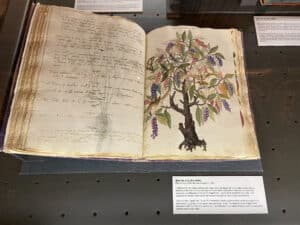
Medieval Botanical Atlas of american plants in Art and Historic Correr Museum (Museo Correr)
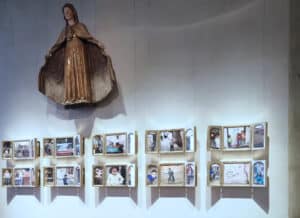
Museum Correr
Beyond Museo Correr: Nearby Sights and Places to Relax
Visiting the Correr Museum will put you right at the heart of St. Mark’s Square (Piazza San Marco) – and there is so much more to see and do in this area. With your museum ticket in hand, we strongly recommend you take advantage of the included entry to the Doge’s Palace next, if you haven’t already. The Doge’s Palace (Palazzo Ducale) is literally across the square, and it’s the former seat of Venice’s government – a masterpiece of Gothic architecture filled with grand halls and priceless paintings. In our experience, touring the Doge’s Palace right after the Correr Museum worked wonderfully: we went from learning about Venice’s history at Correr to walking through the very halls where that history unfolded. (Be sure not to miss the Bridge of Sighs inside the Doge’s Palace, which connects to the old prisons – it’s an iconic Venice experience to walk through that narrow corridor of history.) Additionally, as you exit Museo Correr, you can also pop into the Museo Archeologico Nazionale and the ornate Marciana Library rooms, which share an interconnected route with the Correr – these are often less crowded and provide a quiet glimpse into classical antiquities and a gorgeous historic library interior. We nearly overlooked them, but were glad we took the extra 20 minutes to wander through; it felt like a bonus track to our museum visit.

Bridge of Sighs
Of course, St. Mark’s Basilica towers at the eastern end of the square, only a few minutes’ walk from Museo Correr. If you haven’t been inside the Basilica yet, we tavsiye ederiz making time for it. The basilica is free to enter (though certain areas like the museum or the golden altarpiece have a small fee) – and it’s absolutely breathtaking with its shimmering gold mosaics. When we stepped into the basilica on a later day, we were awe-struck by the atmosphere under those domes. One practical note: lines for St. Mark’s Basilica can be long, so either go early or consider a skip-the-line ticket if you’re on a tight schedule. Another must-do in the vicinity is St. Mark’s Campanile, the tall brick bell tower standing in the square. A quick elevator ride to the top of the Campanile gives you a panoramic view over all of Venice – we did this on a clear morning and the 360-degree view of the city and lagoon was unforgettable. It’s a separate ticket (about €10), but we gotta say it was worth it for the perspective (and photographs!).
After immersing yourself in museums and churches, you might be ready to relax. Luckily, the area around the Correr Museum has some of the most famous cafés in Italy.
We treated ourselves to an afternoon coffee at Caffè Florian, which is located under the arcades on the opposite side of St. Mark’s Square. Established in 1720, Florian is actually one of Europe’s oldest coffeehouses. Sipping a cappuccino there, accompanied by the sounds of a live string quartet playing in the square, was a delightful way to rest after our museum visit. (Yes, it’s pricey – you partly pay for the historic ambiance and the view – but we felt it was a classic Venetian experience we didn’t want to miss.) If you prefer a sit-down meal, there are plenty of restaurants in the surrounding lanes. One place we enjoyed is Osteria Enoteca San Marco, tucked just behind the square – we had dinner there and loved its modern take on Venetian cuisine and the fact that it’s slightly hidden away from the busiest tourist traffic. Another well-regarded spot nearby is Ristorante Do Forni, known for traditional dishes (we’ve not been personally, but it’s a long-standing establishment often recommended for its atmosphere). Keep in mind that anywhere immediately around St. Mark’s can be on the expensive side; if you wander a bit further into the Mercerie (the shopping streets leading away from the square) or towards the Campo Santa Maria Formosa area, you can find more casual bacari (wine bars) and trattorias frequented by locals and informed travelers.
For those who want to do some shopping or grab a souvenir, St. Mark’s Square is lined with luxury boutiques (from high-end fashion houses to famous glass and jewelry stores). Even if you’re not buying, it’s fun to window-shop at the likes of Louis Vuitton or the historic Mercerie shops, and then perhaps step into the Museum Gift Shop (located near the Correr Museum exit) to pick up a book or postcard about Venice’s art. We wandered through the museum’s bookshop and found a few nice art prints and guidebooks. If you need a break after all the walking, you can also find gelato stands and cafes in the vicinity – nothing beats a cool gelato in hand while sitting on a bench by the Venetian lagoon, just beyond the Doge’s Palace, watching the gondolas bob on the water. By the end of our visit, we were a bit tired but extremely fulfilled – between the Museo Correr and its neighboring sights, we spent a whole day in and around St. Mark’s Square and never ran out of things to marvel at.
In summary (without actually saying “in summary”!), a trip to the Correr Museum is more than just a look at museum displays – it’s a step into Venice’s very identity. You’ll emerge with a deeper understanding of how Venice evolved, how its leaders lived, and how its artists thrived. We left feeling enriched and appreciative of the city’s heritage.
We highly recommend including Museo Correr on your Venice itinerary, especially if you have an interest in history or art. And don’t forget: take advantage of that combo ticket to explore the Doge’s Palace and more. By coupling these visits, you get a comprehensive panorama of Venetian civilization, all in the span of an afternoon. Enjoy your visit – we’re sure you’ll come away with new insights and lasting memories from this remarkable museum and its surroundings!

